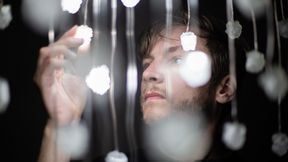Engaging audience and space

The ways how stories are told have a great impact on the ways they are received. After studying documentary film directing, Robbert Groenendijk became increasingly interested in exploring the ways in which viewers could be an active part of the artwork. When watching a film the viewer has a relatively passive role while with installations there are more possibilities to build interactions that can alter the outcome. This way the installation can work as a surface that reflects the viewer’s behaviour and thoughts, each time creating a unique result.
Between sound and image
In Groenendijk’s latest work Echo, a cluster of tiny lights react to the sounds made around them. This work gave the artist a spark that led him to Mänttä Art Festival. For the festival that is taking place this summer in middle-Finland, Groenendijk will create a new installation called Protocol, that utilises digital technology and electronics to allow human interaction: The installation is made up of LED displays which are attached to two computers. These computers decode the image data from these displays to sound and send it over from one to the other using short beeps. They are constantly encoding and decoding the data contained in these beeps, in an effort to reconstruct the images. Because of this custom protocol, human sounds inherently become part of this digital 'conversation', altering the outcome of the work. The installation reflects on human imperfection in relation to the flawless digital systems that govern our daily lives.
After watching a video of the Voyager 1 spacecraft - the spacecraft that carries a golden record with sound and images - Groenendijk was inspired to look into data representations and encoding. It is common for us to think of a record as an object that holds sound. However by designing a particular protocol even the data of a photo can be saved on a record. Therefore the data only actually becomes something when we interpret it.
The studies in Aalto have allowed Groenendijk to dive deeper into his artistic practice and experiment with installations that are based on the digital world: “I’ve had the possibility to shift my work into the physical world, whereas before my work was solely digital. Physical installations allow for a different experience instead of only existing within the screen.”
- Published:
- Updated:
Read more news

Get to know us: Associate Professor Maria Sammalkorpi
Sammalkorpi received her doctorate from Helsinki University of Technology 2004. After her defence, she has worked as a researcher at the Universities of Princeton, Yale and Aalto.
Aalto computer scientists in ICML 2024
Computer scientists in ICML 2024
Getting bacteria into line
Physicists use magnetic fields to manipulate bacterial behaviour